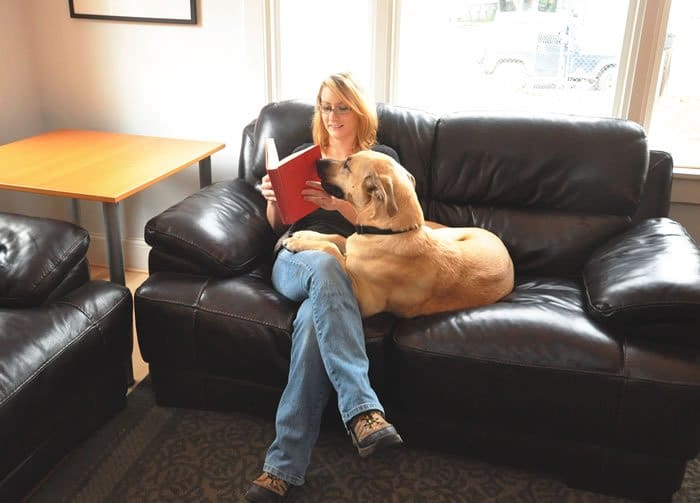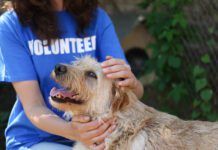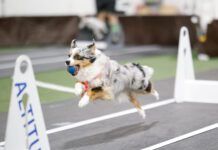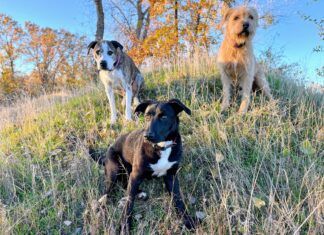Do you live with a canine space invader? These are the dogs who always seem to be in your way – under your feet, blocking your path, nudging a nose under your hand as you try to type on your laptop, pressing tightly up against you as you share the sofa. They are often sweet, appeasing, attention-loving snugglers, so it’s hard to discourage the behaviors, but they can also get annoying. I know this all too well, as Bonnie, our appeasing, beguiling, attention-loving, 9-year-old “Scorgidoodle” (Scottie/Corgi/Poodle), is an exceptionally talented space hog.

Despite what you may have heard, space invaders are not motivated by dominance. Your dog is not taking your space in a pre-emptive strike to take over the world. Usually, dogs who affectionately crowd you are simply seeking your attention, and have discovered that the best way to get it is to be in your space.
Although the behavior can be annoying, it can also be endearing (“Aww, look how much my dog loves me!”), and the dog often gets reinforced for it. I’m as guilty as the next dog owner; I often pet Bonnie when she inserts her nose under my hand or squeezes herself as closely to me as she can on the sofa.
Since the behaviors sometimes get reinforced – behavior geeks call this an “intermittent schedule of reinforcement” – it’s devilishly difficult to stop them, because your dog knows that sooner or later the behaviors will, indeed, succeed in gaining your attention. (When it’s hard to make a behavior go away, behavior geeks call this “resistant to extinction”.) So she keeps trying until it finally works.
The good news is that you don’t have to make the behaviors go away. Instead, just teach your dog to respond to “incompatible behaviors” on cue – that is, behaviors she can’t do at the same time she’s hogging space. I taught Bonnie several incompatible behaviors, and we get along just fine: I can indulge in giving her attention when I feel like it, and ask her to do something else when I don’t.
Incompatible Behaviors
There is a long list of behaviors I could ask my dog to do when she’s being a space invader. Here are some of my favorites:
– Back up – This cue is useful for space-hog dogs who like to park themselves directly in your path. It’s easy and convenient to be able to cue your dog and have her move politely out of your way! You can “capture” the behavior (click and treat when she happens to back up); use a toy or food lure to entice her into backing up; or lure/shape the “Back up” behavior.
To lure, hold a treat at your dog’s nose, then move it down and toward her breastbone. As she leans or steps backward to follow it, click and treat. (Don’t push her back; let her step back on her own.) When she will lure backward easily, add the “Back” cue.
To fade the lure, say the cue, pause to let her think about it (click and treat if she leans or steps back!), and only then should you lure if necessary. Gradually reduce the amount of luring, giving her plenty of time to figure out what you asked for with your cue, until she will back up on the cue alone, with the treat delivered afterward as her reward.
To lure/shape, place a chair against a wall and stand in front of it (with your back to the chair) and with your dog in front of and facing you. Toss a treat between your legs (under the chair) and invite your dog to get it. The goal is to get her to crawl under the chair and then back out, so you can click (or use a verbal marker, such as the word “Yes!”) when she backs up. Then, immediately toss the next treat (the one your promised her, for the click) under the chair again.
Repeat this until the process is working smoothly; then add your “Back” cue just before she backs out from under the chair.
Occasionally do a test run, where you feed the treat directly to her instead of tossing it under the chair, and then just wait to see if she offers a step back. If she does, click and treat, then do several more repetitions of tossing the treat under the chair. As she gets better about offering a step back, you can move away from the chair, stop tossing the treat between your legs, and shape for an increasing number of steps backward.
– Touch – One of the most useful applications of “Touch” (teaching your dog to target her nose to your hand) is to position your dog without having to physically move her.
Space-hog dogs are notoriously good at using the “opposition reflex,” wherein they resist if you try to push or pull them out of the way. (The scientific name for this phenomenon is “thigmotaxis.”) When your dog knows the cue to touch her nose to your hand, you can easily move her out of your way by positioning your target hand off to your side and asking her to “Touch.”
To teach “Touch,” stand or sit with your dog in front of you, offering your open palm four to six inches away from her nose, at nose level or slightly below, with your fingers pointed toward the floor. If she sniffs your hand, click (or say “Yes!”) and give her a treat. If she doesn’t move toward your hand to sniff, rub a little tasty treat on your palm to tempt her to sniff. Repeat until she is deliberately bumping her nose into your palm to make you click and give her a treat. Then add the cue “Touch” as you offer your hand.
When she clearly understands “Touch” in this presentation, position your hand in varying spots and ask her to Touch. You can even move your hand away as she follows it, to position her even farther away from her original location. The better she gets at this, the easier it is to move her wherever you want her without having to physically position her.
– Off – “Off” means “If you’re on something (like the sofa), I want you to hop off.” I use this one with Bonnie when she’s too persistent about snuggling on the sofa and nudging my laptop-typing hands or inserting her head under my elbow, or when I want her to vacate our shared space so I can eat my dinner. When she has hopped off, I might ask her to “Go lie down” (our equivalent of “Go to your mat”) or “Wait!” to prevent her from immediately hopping back up.
It’s quite simple to teach “Off.” Pick a surface where your dog is allowed to be, such as a bed or sofa, and invite her “Up!” Lure with a treat if necessary. Once she is up, invite her “Off!” and toss a yummy treat on the floor. You can click or use a “Yes!” marker each time she hops on and off the furniture on cue. Sometimes, ask her to “Wait” and reinforce this behavior at each location, so she doesn’t develop an “up-off-up-off” behavior chain.
In short order, your dog should be jumping on and off on cue, and you can reward her with a treat after the fact, instead of using the treat to lure. In time, you can “fade” the use of the treat (use it less and less often) so that you reward her with a treat only occasionally, or you can do as I do and continue to reinforce with a treat most or all of the time.
– Find It – This is the easiest exercise to teach, ever. To play the “Find it” game with your dog, say, “Find it!” and toss a tasty treat on the floor near you. If she can’t find it, tap your toe on the floor near the treat. Repeat until she perks up at the “Find it!” cue and looks for the treats on her own. Then start tossing treats farther away after you say, “Find it!” Once she knows the cue, you can say, “Find it!” and toss a treat when you need to move her out of your way.
This can also be a fun way to exercise your dog: Toss a treat as far as you can to your left, and after she runs and eats that one, toss another as far as you can to your right. You can feed an entire meal to her this way! You can also toss a favorite toy to get your dog to vacate your space – though she’s likely to bring it back and ask you to toss it again!
– Go to Your Mat – This is another method for asking your dog to move out of your way. By teaching her a cue that means “go lie down on your bed,” you can get her to go to a specific location – which removes her from your space. My dog Bonnie’s cue for this is “Go lie down.” When she hears this cue, she will find the nearest dog bed in our house and lie down on it. You can lure or shape your dog’s “Go to your mat” behavior.
To lure, call your dog over to a bed or throw rug you have obtained for this purpose. Say, “Go to bed” (or whatever word or phrase you plan to use). Either lure her to the bed with a treat held in your hand, or place a treat on the bed and encourage her to go to it and eat it. Click and give her a treat (or say, “Yes!” and give her a treat) when she does it; then ask her to “Down” and click and treat for that.
Do this a number of times until you think your dog is beginning to associate your cue with going to and lying down on the bed. Then you can start occasionally asking for the behavior without the lure. Click and give a treat when your dog complies.
You can also request a “Wait” so your dog doesn’t pop right back up from the rug. When she is doing this part well, start asking for the behavior when you are farther away from the bed. Ultimately, you should be able to ask your dog to go to her bed from anywhere in the house, which effectively removes her from your space.
To shape this behavior, you simply set up an environment that will allow your dog to easily do the desired behavior, and then click and treat for very tiny steps in the right direction, until you have shaped the entire behavior. Shaping is a fun game; it teaches your dog to think and learn, and encourages her to try to figure out what you want her to do.
Start by standing with your dog within about four to six feet from a rug or mat on the floor. Your dog can be on leash or off leash if she will stay with you and keep playing the shaping game. Watch her closely. Click and treat for any behavior associated with the rug. If she looks at or toward it, click and treat. Click and treat if she takes a step toward the rug, or even if she just leans or turns her head toward it.
When she starts moving toward the rug, even ever so slightly, click (or “Yes!”)and then toss the treat on the floor several feet away from the mat, so she can “reset” herself. In other words, you want her to move away from the mat so she can move back toward the mat (on cue)again. Watch for her movements to start becoming very deliberate – when you can see she understands that moving toward the mat is what makes you click and give her a treat. When she is moving to the rug routinely, start shaping her to sit and then lie down on it.
– Wait – You can use “Wait” to stop your dog from moving into your space in the first place, or to hold her in place when you have successfully asked her to remove herself from your space. It’s like a pause button – not as formal as a “Stay” cue.
The following are two ways to teach “Wait.” Both will teach your dog that “Wait” means “Pause,” and once she knows that you can generalize it to other situations (such as when you see her approaching and you know she’s going to get in your space by jumping on you, parking herself in front of you, or jumping up on the sofa).
Wait for Food:
With your dog sitting at your side, holding her food bowl at chest level and tell her to “Wait.” Move the food bowl (with food it in, topped with tasty treats) about four to six inches toward the floor. If your dog remains sitting, click, raise the bowl back up, and feed her a treat from the bowl. If your dog gets up as you lower the bowl, say “Oops!”, raise the bowl, and ask her to sit again.
If she remains sitting each time you lower the bowl four to six inches, lower the bowl eight to 12 inches. If she holds the sit, click and treat. Repeat this step several times until she consistently remains sitting as you lower the bowl. Gradually move the bowl closer to the floor with successive repetitions until you can place it on the floor without your dog trying to get up or eat it.
Finally, place the bowl on the floor and tell her she can eat! After she has had a few bites, pick up the bowl and try again, lowering the bowl a little farther this time. Repeat these steps until you can place the bowl on the floor and she doesn’t move until you tell her she may.
Wait at the door:
With your dog sitting at your side near a door, tell her to “Wait.” Reach for the doorknob. Click and give her a treat if she doesn’t move. Repeat this step several times. Then jiggle the door knob. Click and reward your dog for not moving. Repeat several times. Slowly open the door a crack. Again, click and reward if she doesn’t move. Repeat several times.
If at any time she does move toward the door, say, “Oops!” and close the door (or, if you haven’t even opened the door yet, just bring your hand back to your side and start over).
Gradually open the door wider on each attempt. When your dog has remained sitting and “waiting” (and you have clicked and rewarded her for doing so) several times with the door all the way open, she’s ready for the next step. Ask her to “Wait,” open the door, and then walk through the door, stopping and facing your dog immediately afterward. Wait a few seconds, click (or “Yes!”), and then return to your dog and give her a treat. Of course, you can still invite her to go through the door any time you want!
More Than One Way
So there you go – a variety of ways to help your dog learn how to give you some space on cue. Because she gets rewarded for each of them, and makes you happy in the process, she should enjoy complying with your requests for space. Choose the methods that appeal to you (or choose them all) and get to work . . . but don’t forget to save a least a little time for snuggling with your dog, too!
Pat Miller, CBCC-KA, CPDT-KA, is WDJ’s Training Editor. She lives in Fairplay, Maryland, site of her Peaceable Paws training center, where she offers dog-training classes and courses for trainers.





